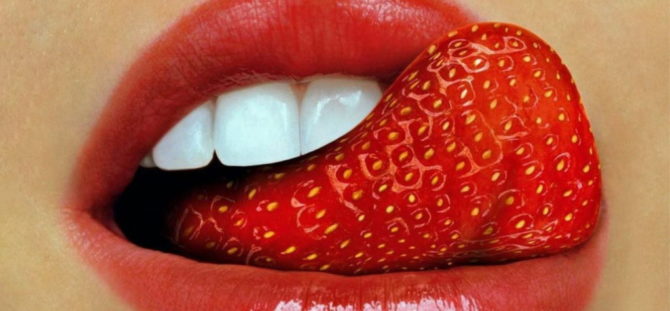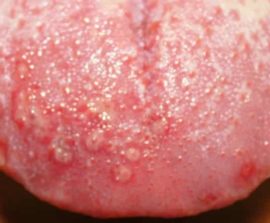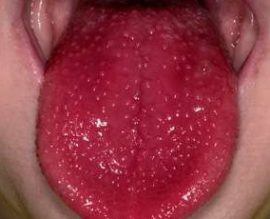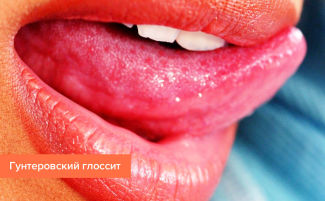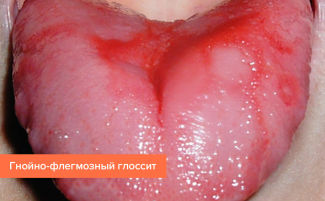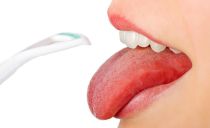Raspberry and bright red tongue in adults and children: causes and treatment
Language is a kind of indicator of health status. Some changes in the color, shape, structure of the taste organ may indicate specific internal pathologies, so you need to pay attention to its appearance.
For instance, raspberry tongue can be a symptom of diseases such as scarlet fever, Kawasaki syndrome, chickenpox, measles. But it can also indicate less obvious pathologies: renal failure, vitamin deficiency. A complete list of diseases in which the tongue may turn red, and methods of dealing with them are listed in the article.
Content
How and why the color of the tongue changes
The language of a healthy person has a uniform pink color without spots and a shallow longitudinal groove in the middle. Only a small amount of a thin translucent white coating on its surface is acceptable. In order not to be mistaken in assessing the state of the organ of taste, you need to examine it in good light and immediately after waking up - before morning brushing and breakfast.
Any unexpected changes in the color and structure of the mucous membrane, which covers the tongue, is an occasion to check the general condition of the body, even if the symptom is not accompanied by any pathological symptoms.
To identify the cause of redness of the tongue, you need to pay attention to such features:
- evenly or partially changed color;
- whether there are spots, rashes, tubercles, sores, seals on the surface;
- whether the nature and amount of plaque have changed;
- what does the surface of the tongue look like: matte or “varnished”, dry or moistened, swollen or loose, with more or less pronounced papillae;
- Does it feel sore?
Causes of redness of the tongue in a child
Most often, the cause of the raspberry color of the tongue in children is the reaction of the body to an allergen, which may be present both in food or household chemicals, and in the environment. Typically, with an allergy in a child, the tip of the tongue blushes, but sometimes the entire organ acquires a red tint.
With an allergic reaction, itching of the mucous membrane of the oral cavity and skin is possible. Symptoms may be accompanied by swelling of the larynx. To prevent such a dangerous consequence, it is necessary immediately, even before a visit to the doctor, to give an allergic person a tablet of an antihistamine that should always be stored in a home medicine cabinet: Suprastin, Diphenhydramine, Diazolin, Clarotadine.
The cause of the appearance of red rashes in the middle or at the end of the tongue in a child can be many diseases of the oral cavity, including stomatitis (glossitis), herpes, early caries. In infants with an incompletely formed esophagus, gastroesophageal reflux is often manifested, in which the contents of the stomach periodically splash out into the oral cavity. Due to a chemical burn, acidic gastric juice becomes bright red and friable. This situation must be discussed with the pediatrician. Special mixtures and medicines will help to fix it.
The tip of the tongue may turn red due to serious malfunctioning of the digestive system or infections in the gastrointestinal tract. Simultaneous staining of the tonsils and mucous membrane of the pharynx, accompanied by swelling of the lymph nodes, is characteristic of dangerous diseases such as a complex form of angina, scarlet fever and Kawasaki disease.In addition, this symptom is observed with influenza, measles, chickenpox and some acute respiratory viral infections, especially if these pathologies are accompanied by high body temperature, weakness, and general disorders.
If the tongue has acquired a bright pink color and an unusual "varnished" structure, it means that the baby’s body has lowered hemoglobin level or is deficient in certain vitamins.
Adolescence and adolescence - the period of wearing braces that can injure the mucous membrane of the oral cavity and cause an allergic reaction in the form of redness. At the same age, powerful hormonal changes occur in children, the result of which is a decrease in immunity, which can affect the condition of the tongue.
Causes of reddening of the tongue in an adult
As in children, in adults the tip of the tongue may turn red due to an allergic reaction. therefore purity of the organ of taste, accompanied by itching or burning - an occasion for the urgent use of an antihistamine and a trip to an allergist.
It is likely that raspberry tongue is a symptom of a chronic illness or a severe infection. Most often, such a sign means the presence of:
- sore throats;
- scarlet fever;
- pneumonia;
- gastritis;
- renal failure;
- some forms of vitamin deficiency;
- anemia.
A tongue of a bright red hue may indicate severe intoxication of the body. If the middle of the muscular organ reddened, and contact with toxic substances was recently carried out, it is necessary to start taking sorbents in combination with a large amount of liquid as soon as possible and call a doctor. Examples of sorbents: Enterosgel, activated carbon, Polysorb.
Many adults, especially the elderly, have bad teeth in their mouths. They are a constant source of infection, affecting primarily the surrounding tissue, and the tongue is no exception.
The appearance of patches of redness in the mouth may be due to recently installed dentures. Perhaps the reason for the red color of the tongue lies in an allergic reaction to the materials from which the implants or crowns are made, or to the medicines used in the treatment and prosthetics of teeth.
At any age, the condition of the teeth and gums should be treated scrupulously. This will help prevent many health problems not only in the oral cavity, but also in the internal organs, which also suffer from the constant presence of infection in the body.
General factors leading to reddening of the tongue
There is a specific disease of the tongue - glossitis - which occurs either as an independent syndrome, or as a symptom of other diseases. Pathology can be traumatic, bacterial, viral, fungal and allergic in nature. Also distinguish such varieties of glossitis as Gunter, purulent-phlegm, ulcerative, catarrhal.
The disease is characterized by the appearance of individual red spots or a change in the color of the entire surface of the taste organ, a feeling of weakness and discomfort, the appearance of islets, erosions, ulcers, aphthae and a number of other unpleasant manifestations. Only a comprehensive examination of the body allows you to determine the cause of inflammation of the tongue and draw up an effective treatment plan.
Physical, chemical and thermal injuries
The reason that the tongue has turned red but has a flat surface may be a thermal or chemical burn, injury or biting while eating too hard food. In addition, the taste organ could turn red from staining food, drinks with food colors, medicines and cosmetics.
The mucous membrane of the child’s oral cavity could turn red in color from pencils and paints, poor-quality toys and fabrics that had been in the mouth of a small researcher.
If the sudden redness of the mucous membrane of the oral cavity is not associated with any of the external causes, then the raspberry color of the tongue is a sign of some kind of internal disease.
Taking antibiotics
Severe infectious diseases are treated with antibiotics that disrupt the natural microflora in the mouth and may contain components that cause an individual intolerance reaction. A red tongue after prolonged use of antibiotics indicates that you need to change treatment tactics or take a course of rehabilitation therapy.
Other pathologies
At any age - from young to old - parasites can be present in the body, the vital products of which provoke irritation of the skin and mucous membranes in the oral cavity, because of which they turn red. In addition, raspberry tongue in adults and children is observed in diseases of an immune nature and oncological processes.
How to treat a reddened tongue
The tactics of treatment for complaints of red tongue are always individual, since the tongue can turn red for various reasons. A physician should identify the factors that contributed to the manifestation of such symptoms. He will prescribe all the necessary medicines and procedures.
In many cases, additional tests are needed to determine the treatment tactics for the causative disease: scraping of the tongue, sputum and blood tests. Only by eliminating the cause of the symptom can you get rid of it forever. That is why a person should not ignore the red tint of the surface of the tongue.
Auxiliary agents that can be used during treatment to relieve inflammation and eliminate discomfort are local anti-inflammatory drugs:
- rinses and lotions based on chamomile or calendula;
- treatment of all mucous membranes in the oral cavity with a solution of Chlorophyllipt or Furacilin;
- drawing on the lesions of healing ointments, for example, Solcoseryl or Holisal.
Until the redness of the tongue is completely eliminated, you will have to refrain from eating hot and cold foods, acidic, spicy, very sweet foods. Warm soups or mashed potatoes should be preferred. Hard meat, hard vegetables and fruits can be introduced into the diet only in pureed form. Alcohol and smoking should be completely eliminated.
Since the state of the whole organism is reflected in the language, do not forget about general strengthening procedures that will help restore strength during the illness and after recovery. These include proper nutrition, walks in the fresh air and moderate exercise.
Daily oral hygiene should include brushing not only teeth but also tongue - for the implementation of this procedure, there are special scrapers. Regular cleansing of the surface of the organ of taste from bacteria accumulated on it will help to avoid weakening of immunity and, as a result, the development or relapse of various diseases and redness of the mucous membranes in the mouth.

